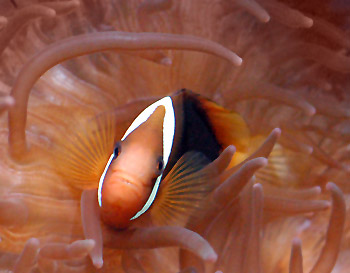| | | 
| Fire Clownfish Description of the Fire Clownfish
The Fire Clownfish is also known as a Cinnamon Clownfish, Dusky Anemonefish or Black Clownfish. Clownfish are often also known as Anemonefish, due to their close relationship with sea anemones. They are Omnivores which means that they eat both plant and fish materials. |
| Picture of a Fire Clown Fish | |
| |
Fire Clownfish
Facts - Information - Picture - Video Popular Name: Fire Clownfish
Species: Amphiprion melanopus
Profile of the Fire Clownfish
This Profile contains interesting facts and information about the Fire Clownfish species.
Size: up to 12cm
Fish Tank conditions: Temp: 22-23 Degrees, PH: 8-8.5
Temperament: Good Community Fish but ensure they are placed in pairs with a sea anemone to mimic their natural environment
Diet / Feeding: Frozen, Live or Flaked food
Habitat: Lagoon and Reef dwellers in marine waters, depth of up to 18m
Behaviour: Can be territorial towards other Clownfish, place in pairs
|
| |
Scientific Classification of the Fire Clownfish
Definition: Scientific classification, or biological classification, is how biologists group and categorize species of organisms with shared physical characteristics. Scientific classification belongs to the science of taxonomy.
Interesting Facts and Information - How do you identify the sex of a Fire Clownfish?
The males and females of many fish species have different colors or different shaped bodies. But there are also other fish species where there is no visible difference. Its sometimes tricky being an ichthyologist! |
| |
Interesting Facts and Information - Why are Fire Clownfish slimy?
Fire Clownfish secrete a type of mucus, or slime, from their skin. This slime provides protection against parasites and infections and helps the Fire Clownfish to move through the water faster. Some fish species also release toxins in their slime which ward off enemy attacks. Other fish species use their slime to feed their young.
Interesting Facts and Information - Why do Fire Clownfish have gills?
Gills enable the Fire Clownfish to breathe. Gills consist of thin sheets of tissue containing blood vessels. As water passes over the gills oxygen is absorbed into the blood stream Carbon dioxide passes out into the water. The gills are protected by a large bony plate called an operculum. Some fish species however have lungs and breathe air.
Interesting Facts and Information - Why do the Fire Clownfish have fins?
A fin is an external appendage or "limb" of a fish. Fins are used for directing, stabilizing, or propelling the different fish species in water. Numbers of fins vary between fish species, but there are usually seven. Each of the fins on a fish are designed to perform a specific function:
|
| |
Pectoral fins. The Pectoral fin is located on the breast area of fishes. The Fire Clownfish has Pectoral fins to for locomotion and side to side movement.
Fire Clownfish
Why do the Fire Clownfish have gills?
Facts about Fish Species - Why do the Fire Clownfish have fins?
|
| |
|
Facts About Fire Clown Fish The female clownfish can lay up to 1000 eggs at a time and they hatch in about seven days
Clown fish are monogamous, they mate for life. If the female dies, the male fish will change sex and become female. She will then mate with one of her own offspring!
| Fire Clown Fish - Top Tips Clown fish are poor swimmers and never venture far from their host anemone.
The female clownfish is always larger than the male!
Despite their ‘clown’ name and image the clown fish is an aggressive fish and very territorial
| |
|